Every brand wants attention. Not just any attention, but the kind that shows up in search engines. Measuring your share of search tells you how often people search for your brand compared to all other brands in your industry.
It’s a powerful indicator of brand health, online visibility, and shifts in market share.
In this post, you’ll learn what share of search actually means, how to calculate share using tools like Google Trends and Google Keyword Planner, and how to use that insight to improve your brand’s visibility through meaningful SEO.
What is share of search?
Share of search (SoS) is the percentage of total search volume for a category that goes to your brand name (i.e., branded searches) compared to all brands in that category.
Les Binet introduced this SEO metric at the EffWorks Global 2020 Conference.
Here’s a quick formula to calculate a brand’s share of search:
Brand’s share = (Brand search volume ÷ Total branded search volume for all brands) × 100
Let’s say we look at three sportswear brands:
- Nike → 500,000 branded searches
- Adidas → 300,000 branded searches
- Puma → 200,000 branded searches
In this case, the total branded keyword search volume = 1,000,000. Nike’s brand share of search = (500,000 ÷ 1,000,000) × 100 = 50%.
This means half of all branded search queries in this category are for Nike.
Unlike non-branded keywords or generic terms like “running shoes,” share of search zeroes in on brand names. It uses search engines and their organic search queries as a proxy for brand interest, essentially reflecting how much attention a brand commands in the minds of consumers.
Why is share of search important?
Your brand’s share of search matters because it reflects how much attention your brand commands in search engines compared to other brands. Every time someone types your brand into Google, it’s a signal of awareness, trust, and consumer interest.
“Share of search is not only a strong predictor of market share, but can also act as a convenient way for measuring brand health.”
That means a rising trend in branded searches often points to stronger brand visibility and improved future sales performance.
Research from the IPA and Vizer Consulting also found that share of search has been found to represent 83% of a brand’s market share.
That means shifts in SoS often mirror and even predict real changes in how a brand performs in the market.
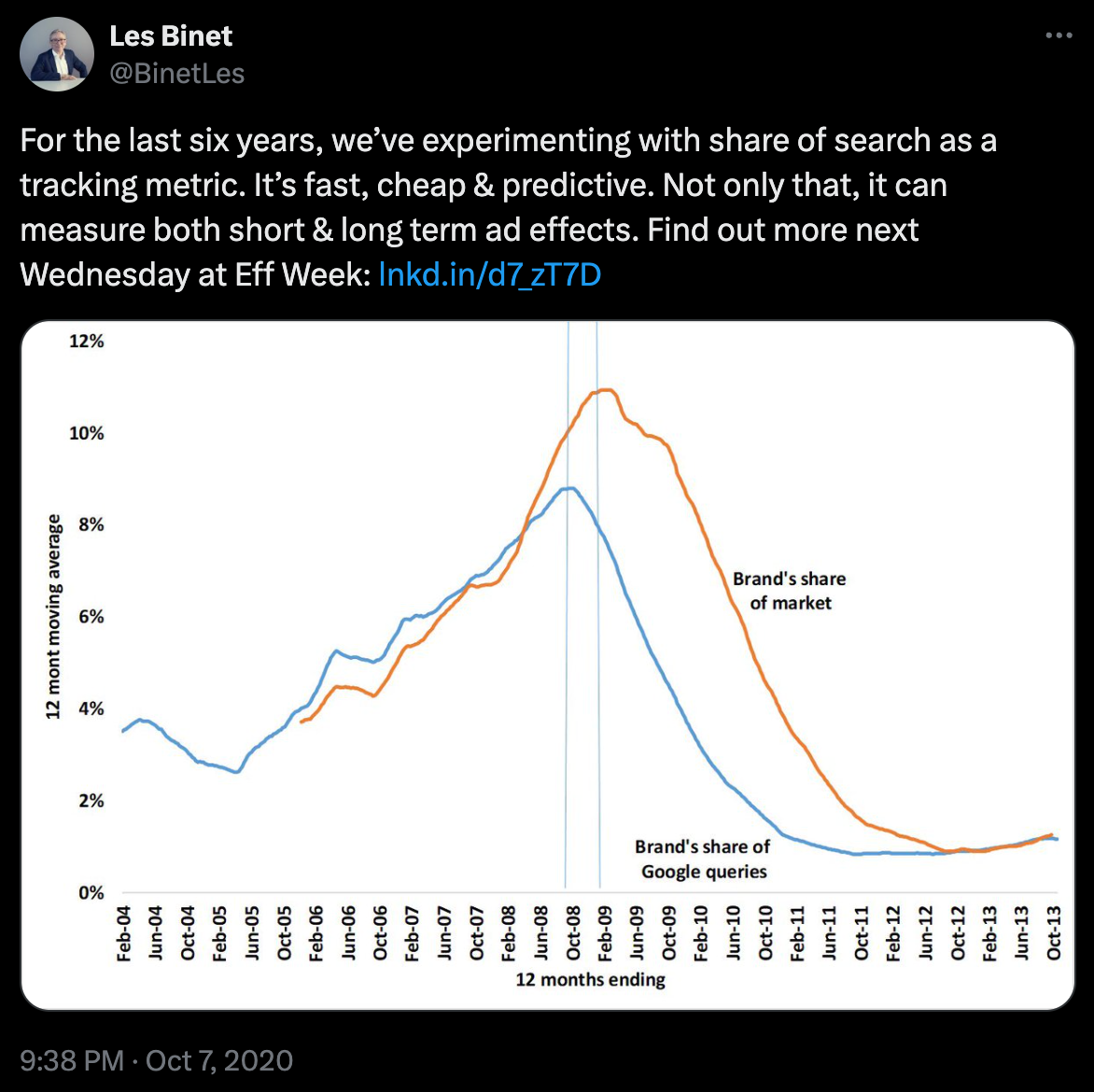
Here’s why tracking SoS matters:
- Understanding brand health in SERPs: Branded searches are proof that people already recognize and trust your brand. Tracking your brand's share of searches over time gives you a pulse check on brand health and online visibility.
- Competitive benchmarking: Share of search shows which competitors are gaining or losing traction. By comparing your branded searches to theirs, you can identify shifts in consumer interest and adjust marketing campaigns accordingly. Adding SoS to your ongoing SEO or digital performance reports ensures you’re not blindsided by competitor momentum.
- Complementing traditional SEO KPIs: SoS adds another dimension to metrics like keyword rankings, organic traffic, and CTR. By integrating SoS into your SEO dashboards, you move beyond surface-level performance to see how your brand stacks up in the bigger market context.
- SEO implications: Google often prioritizes well-known brands because searchers are more likely to click on them. Greater brand awareness drives higher CTRs, which in turn can improve rankings.
For instance, when you search for ‘running shoes’ on Google, Nike and Adidas almost always appear at the top of the results. Smaller brands with similar products rarely break into those prime spots.
This is because well-known brands attract more branded searches, higher CTRs, and stronger trust signals that Google’s algorithm factors in.
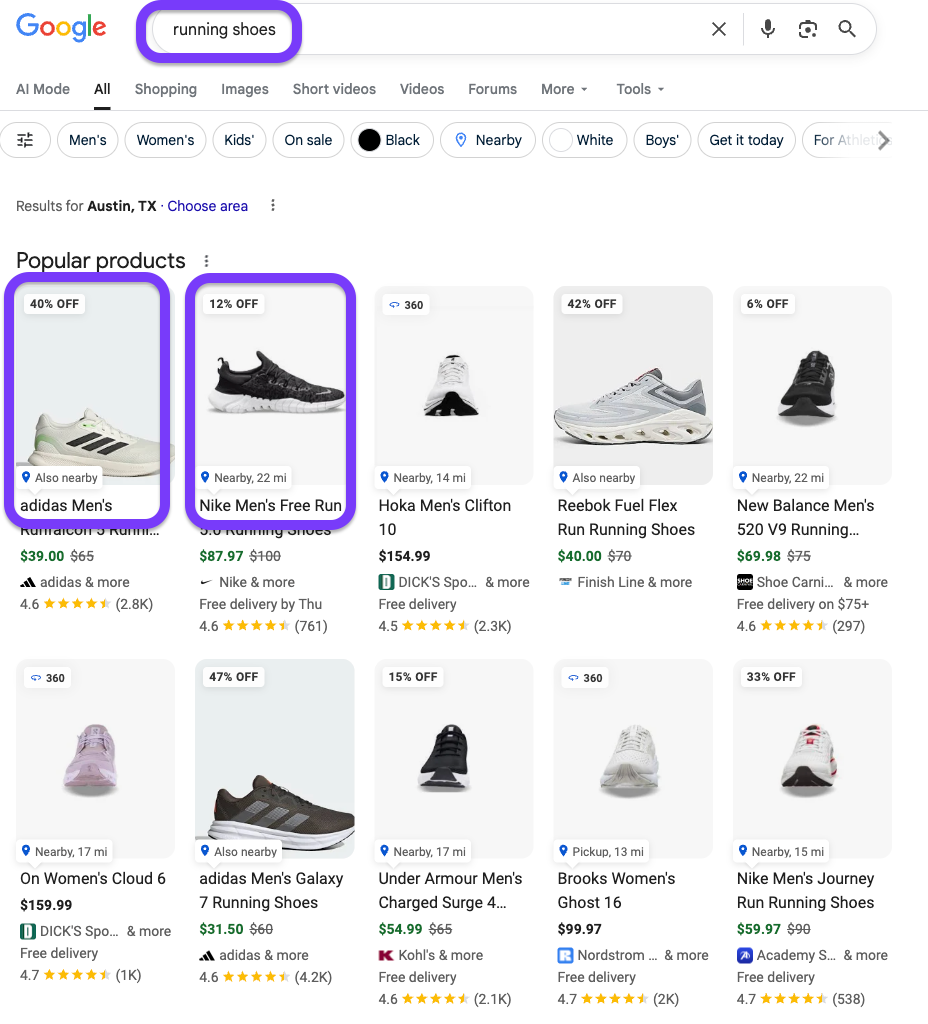
In short, measuring share of search gives marketers a reliable way to link search visibility, brand metrics, and market share using actual search data instead of assumptions.
How to measure share of search in 5 steps
Measuring the share of search marketing metric involves the use of search tools to analyze total search queries for tracked keywords relevant to your brand and tracking how that changes over time.
But it’s not as difficult as you think. Free keyword research tools like Google Trends, Google Keyword Planner (or Google Ads), and Surfer’s Chrome extension are enough to give you accurate market research.
Here’s how you can use these free tools to measure share of search:
1. Identify branded keywords
The first step is to create a keyword overview list that represents your brand and all the brands in your niche. These keywords shouldn't be generic search terms, but specific to brand names and their variations.
Examples:
- Starbucks cappuccino
- Starbucks near me
- Dunkin’ menu
- Costa Coffee locations
Your best source to identify branded keywords for your business is Google Search Console.
- Head to GSC and click Performance > Search results in the left sidebar
- Click the Queries tab below the graph. This will show you the search queries your site appeared for.
- Click + New > Query and choose “Queries containing”.
- Type your brand name and any close variations one at a time.
- For example: Surfer, Surfer SEO, SurferSEO
- Click Apply or create a regex.
Now your report shows only branded search queries — people searching for you by name.
In actual practice, you'll find that people look for your brand using several misspellings and variations.
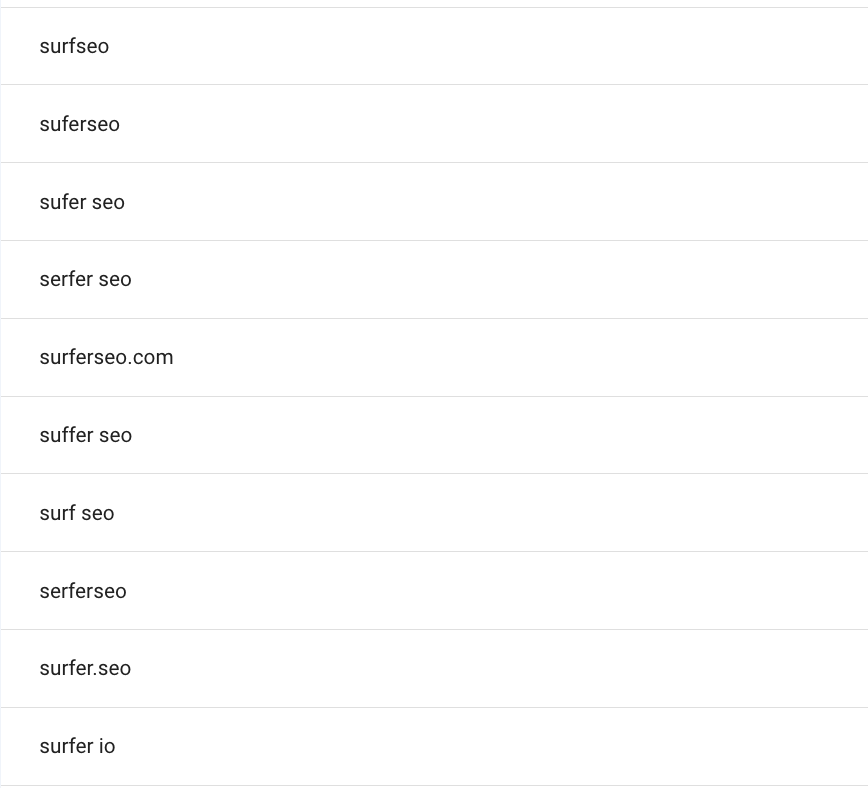
You can export your queries report and feed into an AI tool like ChatGPT, to find all variations of branded keywords.
Then build a regex formula that you can enter into the GSC filter.
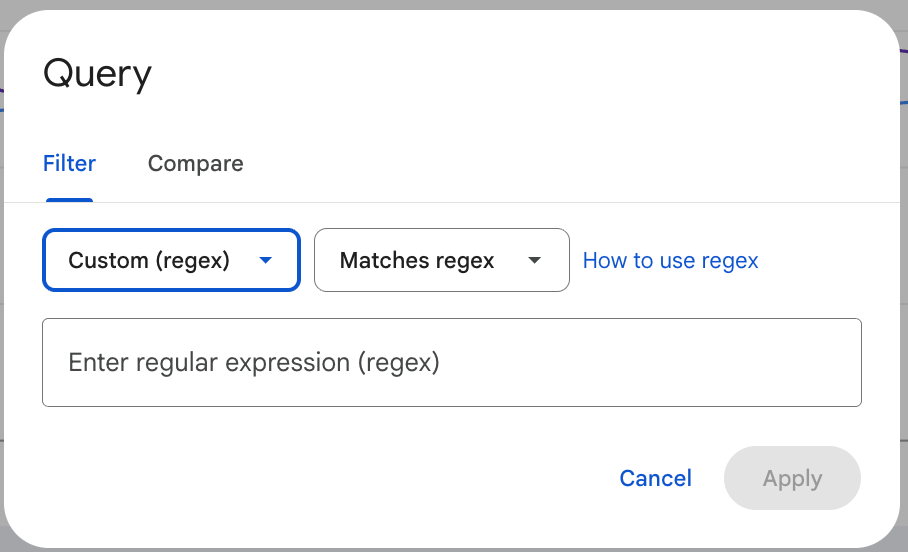
An example regex for brand “Surfer SEO” looks like this.
surf[\s\-\.]?(er|ar|or|a|e)?[\s\-\.]?(seo|se|io|\.com)?
Here's what the regex is telling GSC,
“Match any query that starts with surf, maybe followed by a space/hyphen/dot, maybe followed by a variant of er/ar/or/a/e, maybe followed by another space/hyphen/dot, maybe ending with seo/se/io/.com.”
Using Google Trends:
- Go to Google Trends.
- Type your brand name (Starbucks) and click “+ Compare” to add competitors like Dunkin’ and Costa Coffee.

- Switch the filter to your target geography and timeframe (e.g., past 12 months).
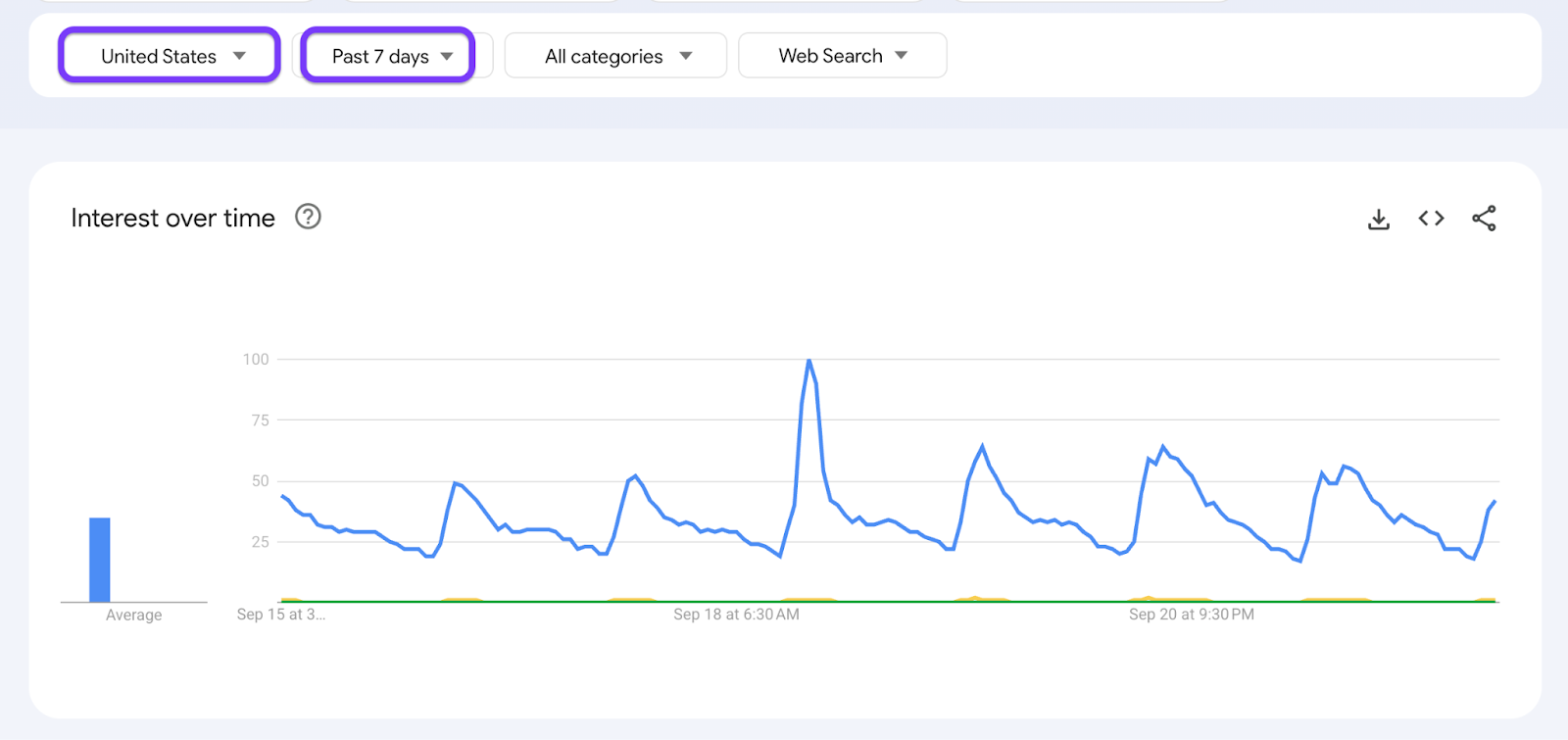
- Scroll to the “Related queries” section — this reveals popular branded keyword variations you may not have considered.
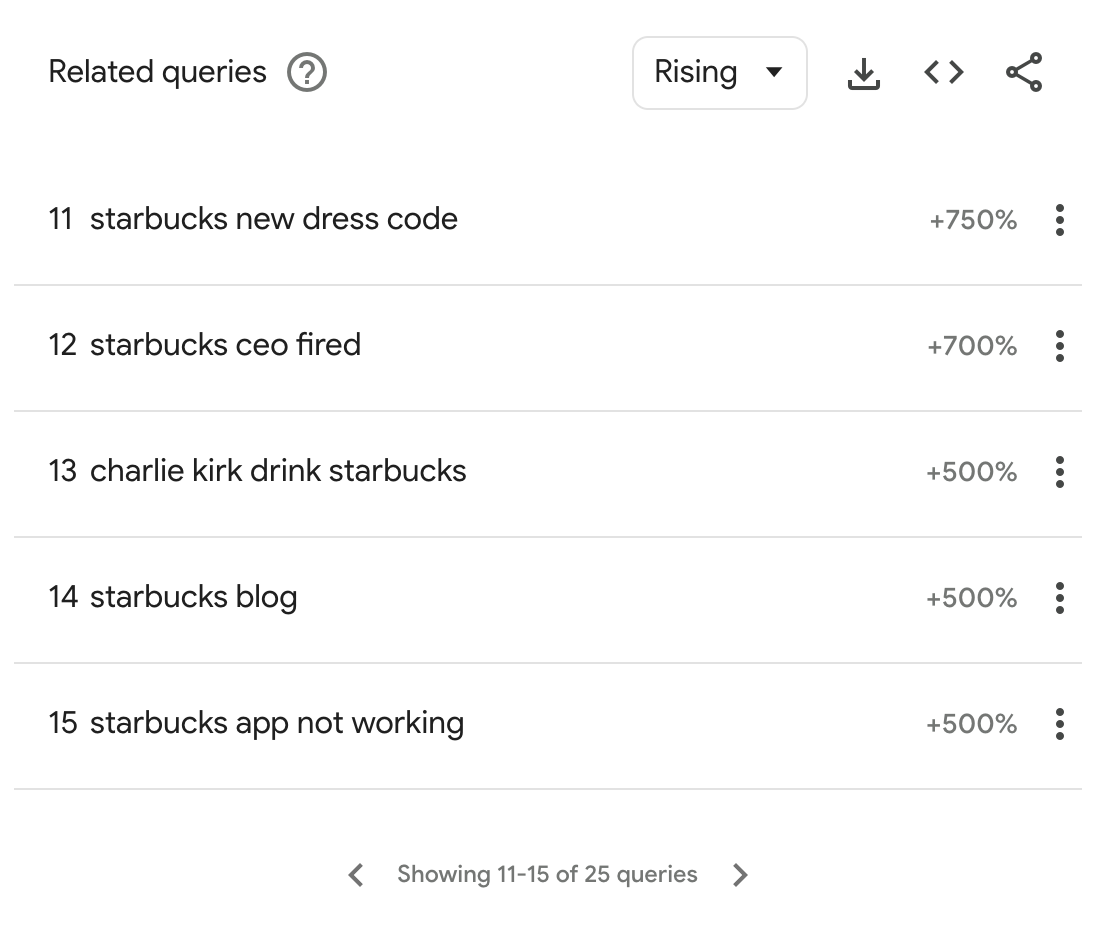
If you want to speed up the process, the Surfer Keyword Chrome extension lets you see keyword overview data like monthly search volume, keyword difficulty, and related phrases directly within Google SERPs.
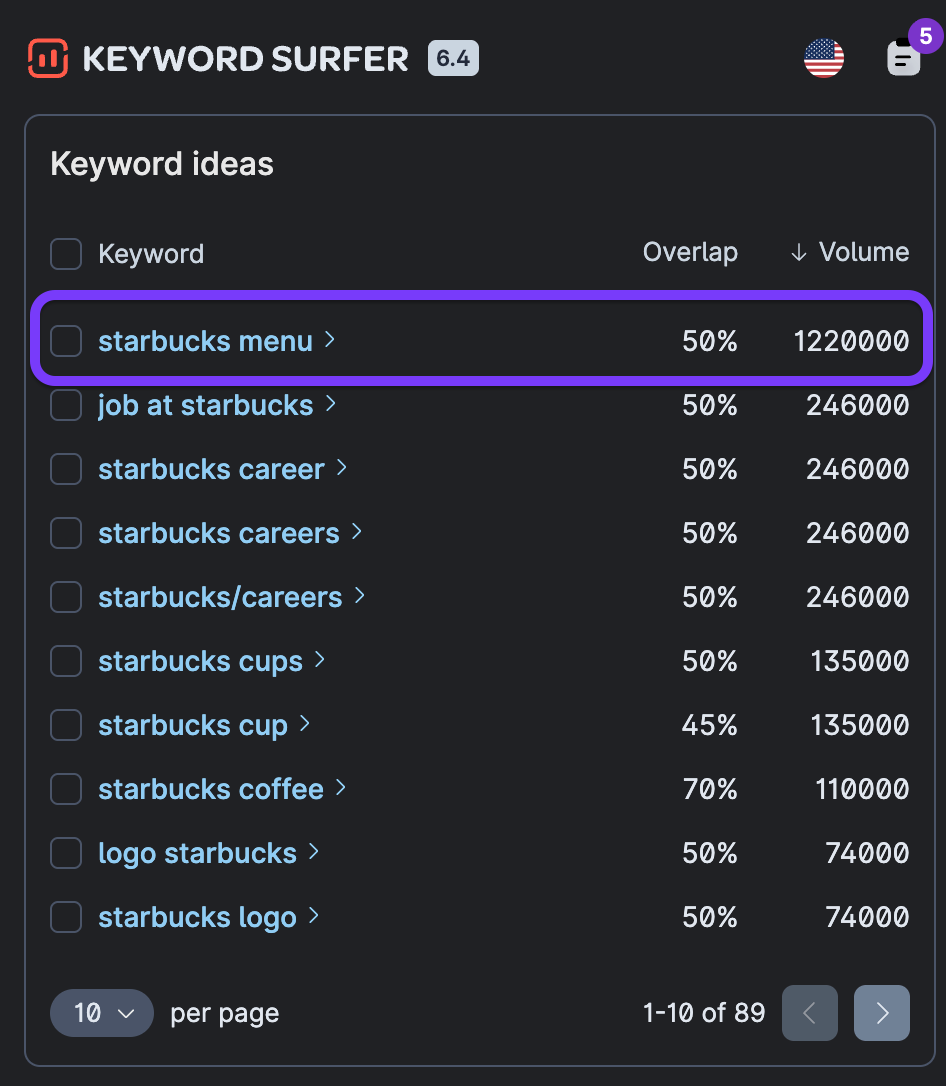
For example, when searching “Starbucks cappuccino”, the extension can instantly show you how popular that term is and suggest other branded keywords.
This makes it easier to build a list of relevant keywords.
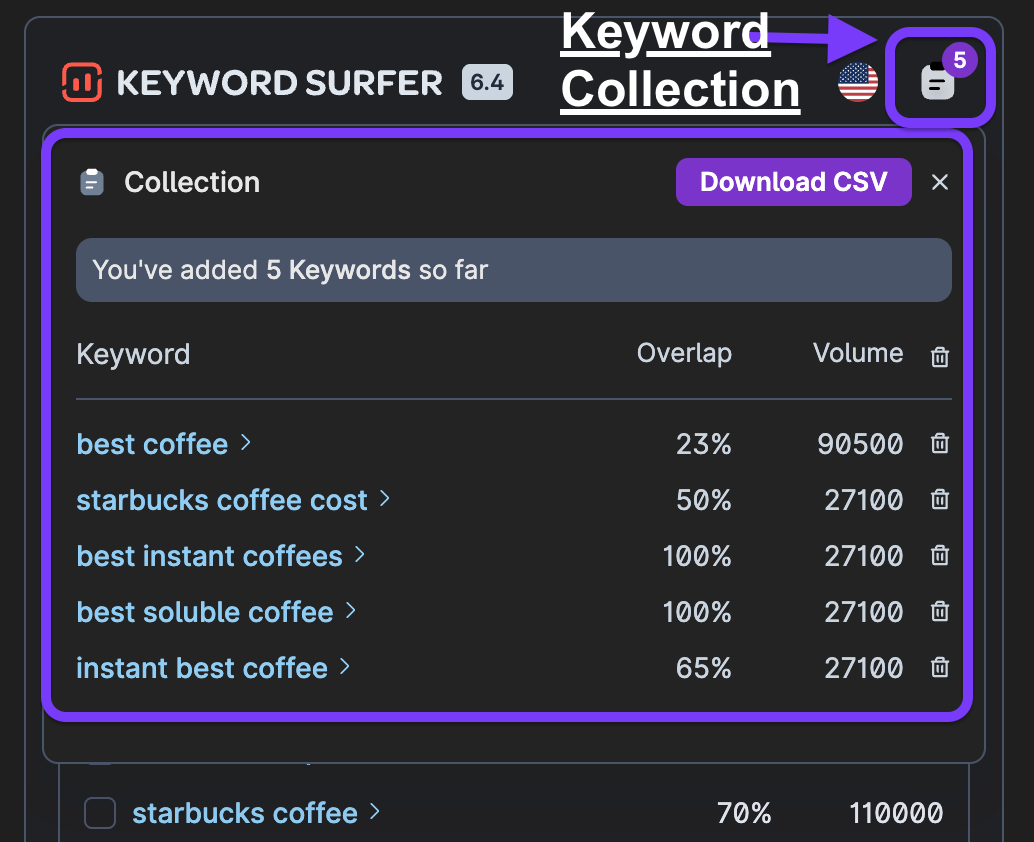
2. Collect search volume data for your niche
The foundation of measuring share of search is building a reliable list of branded keywords for your niche. And this isn’t just the primary brand name, but all the different ways people search for it.
These could include:
- Brand + product (“Starbucks menu”, “Dunkin iced coffee”)
- Brand + career (“Starbucks jobs”, “Costa Coffee careers”)
- Brand + location (“Starbucks near me”)
You can also use Surfer's Keyword Chrome extension to keep track of accurate data for organic keywords directly in the search results.
- Install the extension and search for your competitor's brand on Google.
- On the right-hand side of your Google SERPs, you’ll see a panel showing branded keyword ideas with their monthly search volumes.
- Example: For “Starbucks”, related searches include “Starbucks menu” (1.22M), “Starbucks coffee” (110K), and “Starbucks careers” (246K).
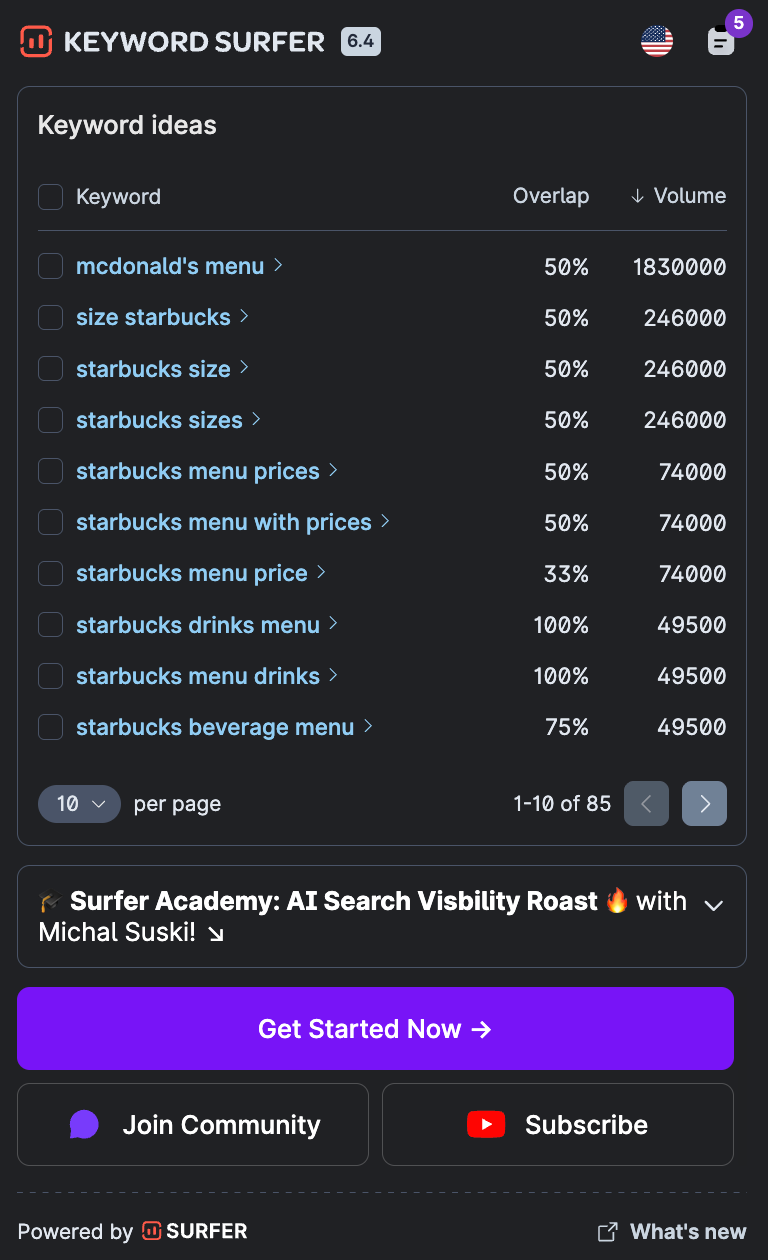
- Click the checkboxes to collect multiple branded keywords into a custom list.
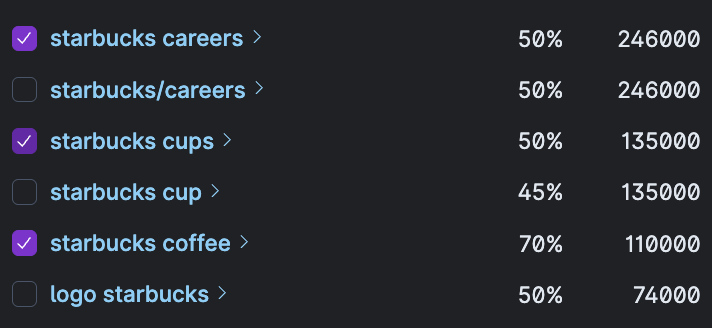
- Download the CSV export for a ready-made branded keyword dataset.
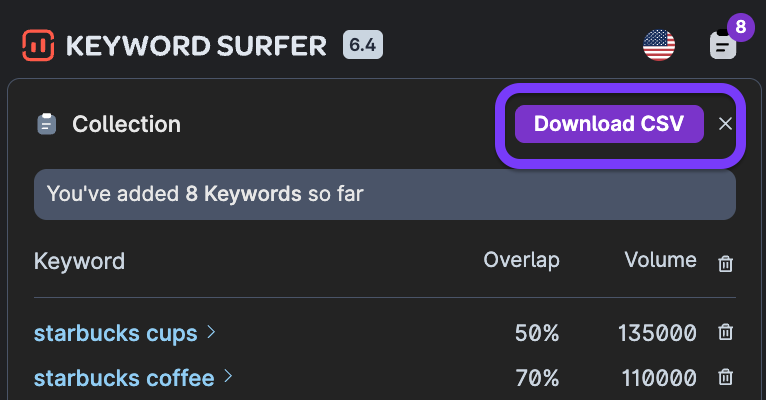
This method saves time compared to manually compiling keyword search volume trends and ensures you capture all branded queries, from the obvious to the overlooked.
It works for measuring the share of search for your competitors' branded keywords, letting you build side-by-side lists to compare and benchmark your marketing efforts against theirs.
3. Calculate share of search formula
With search volumes collected, apply the formula:
Share of Search = (Brand search volume ÷ Total branded search volume for all brands) × 100
Example:
- Starbucks = 400,000
- Dunkin’ = 250,000
- Costa = 150,000
Total = 800,000
- Starbucks = (400,000 ÷ 800,000) × 100 = 50%
- Dunkin’ = 31%
- Costa = 19%
This shows that Starbucks commands half the brand search volume in this category.
4. Use Google Trends to identify long-term patterns
While keyword tools provide current estimates, Google Trends data highlights shifts in consumer attention over time.
Here’s how you can use Google Trends effectively to identify long-term patterns for share of search:
- Compare your brand's target keywords with competitor brand names in Trends.
- Select a multi-year timeframe (e.g., last 5 years) to spot growth or decline.

- Export the CSV to track how branded interest changes.
- Overlay your calculations from keyword research tools and Google Trends curves to explain fluctuations.
For example, trends might reveal that Starbucks peaks every December (holiday campaigns), while Dunkin’ spikes in the fall with pumpkin spice promotions. These recurring patterns explain why SoS changes seasonally.
Keep in mind that a value of 100 is the peak popularity for the term. A value of 50 means that the term is half as popular. A score of 0 means there were not enough data points for the term.
For a sound SEO strategy, pair your findings with a competitive content audit.
This means that if Dunkin’s branded searches rise sharply in October, check their blog posts, advertising spend, website's performance, and social media pushes from that period.
This helps connect marketing activities with your target audience and changes in SoS.
5. Track your share of search in AI answers
As the newest discovery channel, AI answer platforms attract users seeking direct answers without the hassle of ads on traditional platforms.
Users on these platforms are also shown to convert at a higher rate.
Surfer's AI Tracker can help you monitor your share of search directly within responses generated by LLMs like ChatGPT, Gemini, and Perplexity.
This helps you track a set of prompts you specify and identifies the domains cited or referenced in the AI's replies, thus giving you insights into your AI share of search.
Here’s how.
- Head to AI Tracker in your dashboard
- Configure your brand, topic, audience location and prompts to track.
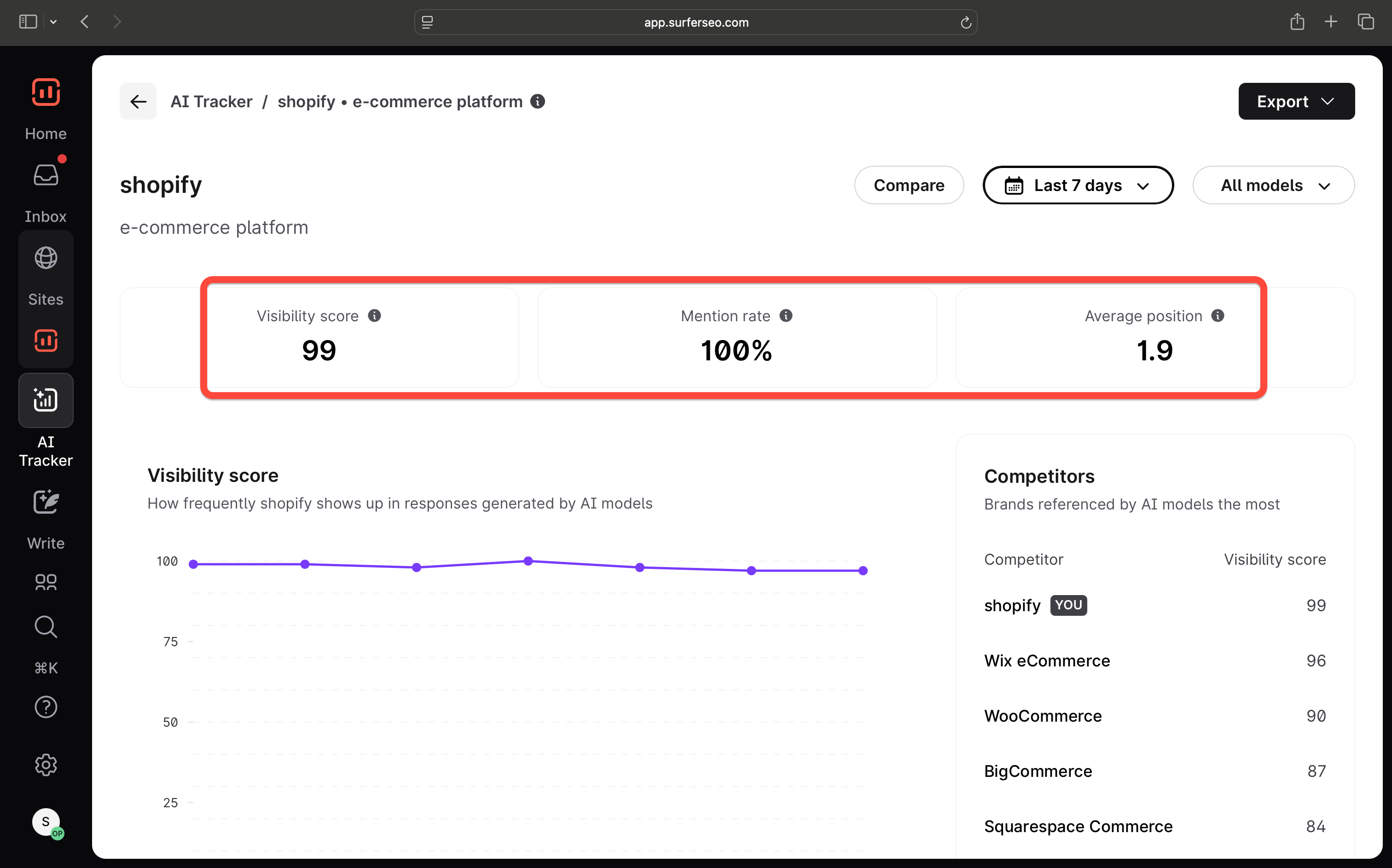
Surfer analyzes LLM responses for prompts, reporting your website's visibility and brand mention scores.
4 ways to improve share of search
Measuring your brand’s share of search gives you valuable insights into your marketing strategy, online visibility, and market share.
But the real question is: how do you actually improve it?
Driving more people to type your brand name into search engines requires a mix of SEO, content, and brand-building tactics.
Let’s look at four proven ways to significantly enhance your share of search.
1. Claim unbranded mentions
When your brand is mentioned in an article, directory, or review without a link, you miss out on authority and visibility that a link would have provided. These brand mentions prove you’re part of the conversation, but if they’re not linked, Google can’t tie them back to your site.
Here’s why turning these mentions into backlinks strengthens your authority around branded keywords and improves search visibility.
Start by monitoring non branded searches with free tools like Google Alerts. You can also run a manual Google search and use search operators like:
"Your Brand"site:yourdomain.com
This will surface unlinked mentions across the web for relevant websites where you may be mentioned.
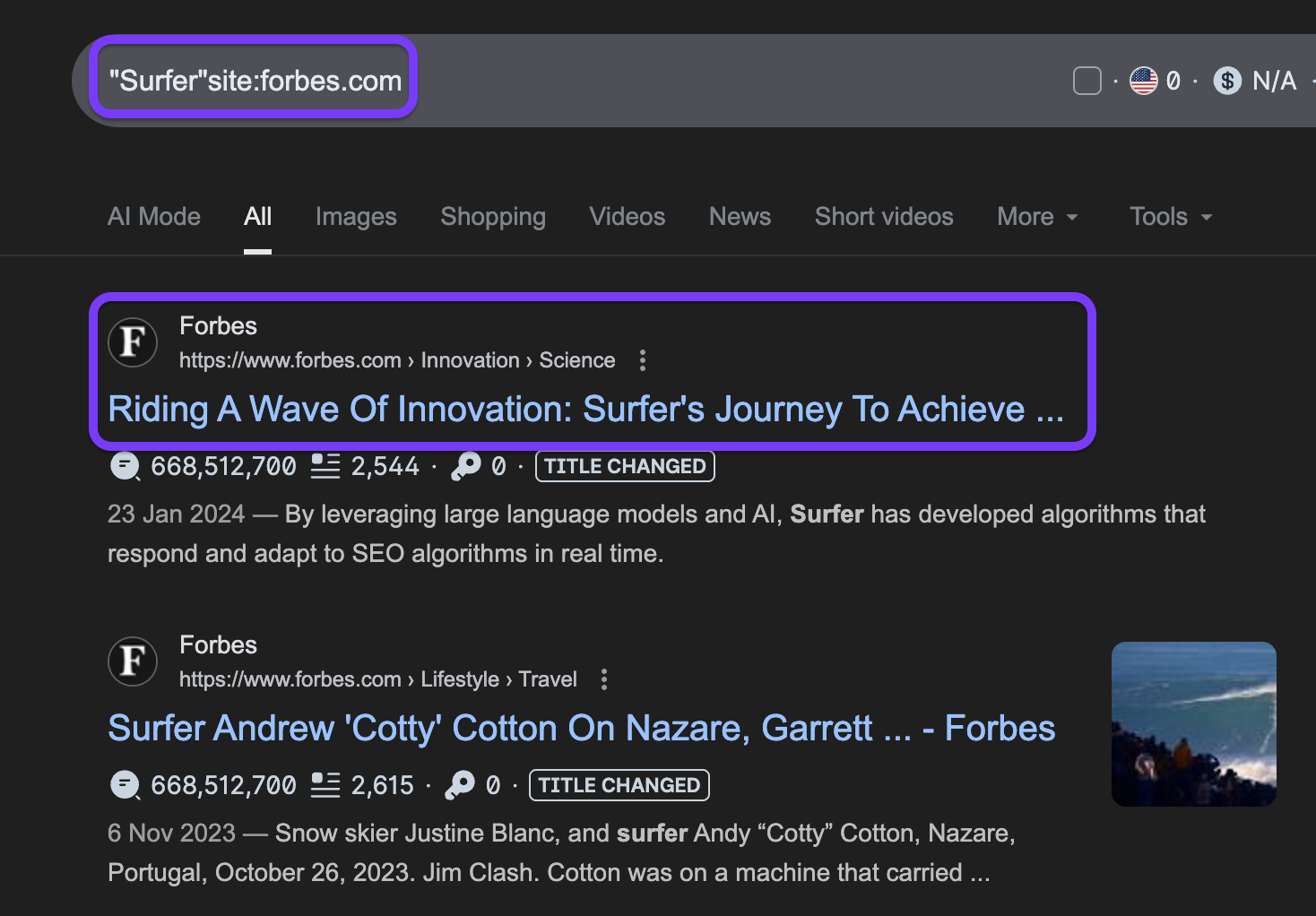
From there, prioritize high-authority domains and reach out with a value-first message. For example, suggesting a link to your homepage or a product page that adds context for their readers.
In fact, research from Ahrefs also shows that “branded web mentions were the highest correlating factor with visibility in AI Overviews — more so than traditional backlink metrics.”
In other words, every mention matters, but securing a link multiplies the benefit.
2. Target branded keywords
Branded keywords like “[Brand] pricing”, “[Brand] reviews”, or “[Brand] alternatives” are some of the highest-intent queries your target audience will ever type. If you’re not ranking for them, you risk letting competitors, affiliates, or review sites define your story.
That’s why building a content library around branded terms is essential.
This includes comparison pages, integration guides, product FAQs, and testimonial content like case studies that aligns directly with how people search. To really stand out in Google search, structure your metadata and schema to reinforce brand presence.
Zapier is a great example of how they target brand search queries.
By creating multiple pages, from integrations like “Zapier and Slack” to comparisons like “Zapier vs Make,” the company ensures its brand dominates the SERPs, without additional paid advertising.
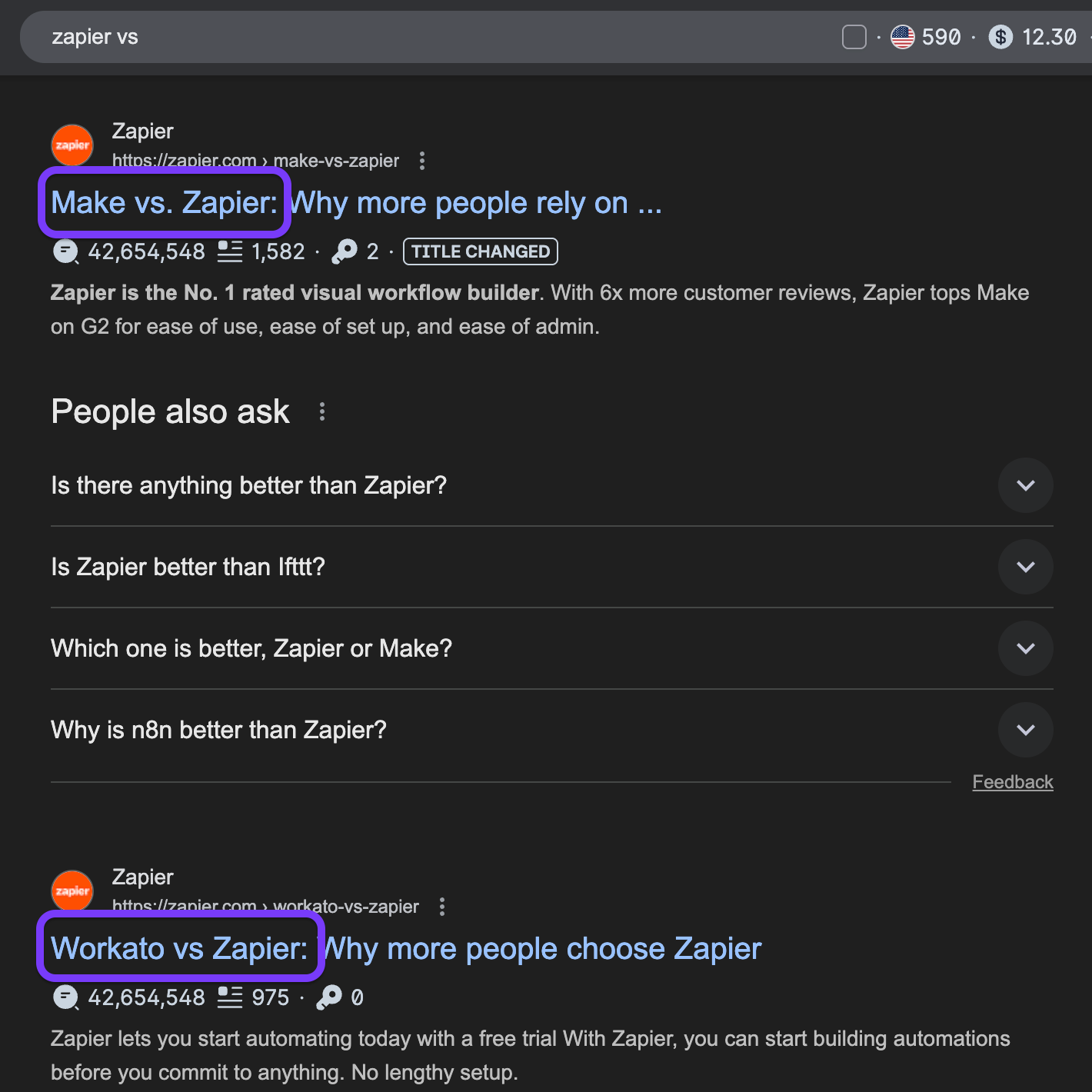
This leads to stronger brand visibility, a tighter grip on brand’s online presence, and insulation against competitors ranking for its own terms.
3. Perform competitive backlink analysis
Your competitors’ backlinks often explain why their branded queries outperform yours. If they’re earning coverage in high-authority sites, listicles, or industry blogs, their brand names get reinforced in the places consumers trust most, which is what drives branded searches.
You can use a free backlink tool to find pages linking to other websites.
Start by running a backlink report for a competitor, filter by anchor text containing their brand name, and sort by authority and traffic.
This gives you a map of where they’re being mentioned.
Next, identify gaps: could your brand be included in the same roundup, or replace outdated references with fresher research?
If so, you can suggest creating “better” or more up-to-date content on the same topic to replace or supplement competitor-linked content.
This is a long and arduous process, so dont expect to have results overnight. Website editors are inundated with link requests and your best bet is to build long-term relationships on LinkedIn and link communities.
You may also consider outsourcing this to an experienced link-building agency that'll have existing relationships.
We know that Google and LLMs prefer brands and rely on authority, so branded mentions may matter more than non branded links.
That means every time your competitor earns a mention without you, their share of search edge grows.
By systematically closing these gaps, you build parity in authority and make it more likely for consumers to search for your brand alongside or instead of competitors.
4. Launch brand-building campaigns with SEO focus
Campaigns are one of the fastest ways to spark branded search demand. When consumers see or hear about your brand in culture, they turn to search engines to learn more, and those searches feed directly into share of search.
The key is to design campaigns with SEO baked in.
Personal stories and original data are two of the most effective ways to earn media coverage and backlinks because they offer authenticity and uniqueness. Personal stories humanize your brand — journalists love narratives that feel relatable and emotionally engaging.
Meanwhile, original data gives credibility and novelty — publications often seek new insights, statistics, or studies that haven’t been reported elsewhere.
By combining the two (e.g., sharing founder insights backed by proprietary research or customer trends), brands can create PR angles that stand out, feel trustworthy, and are more likely to be cited by journalists, bloggers, and thought leaders.
This study from Axios, for example used original data and was widely shared.
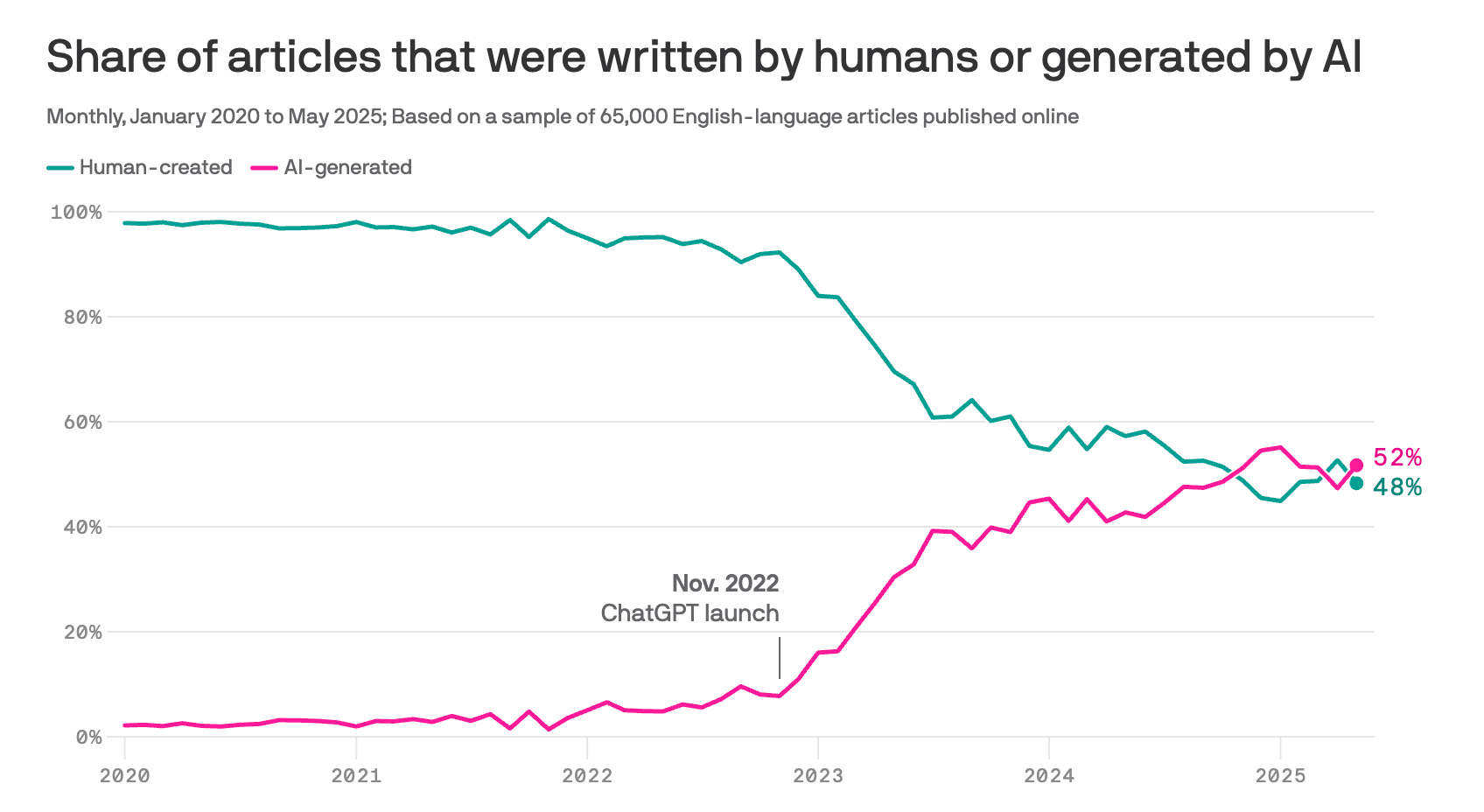
It also resulted in almost 300 backlinks from over a 100 websites.
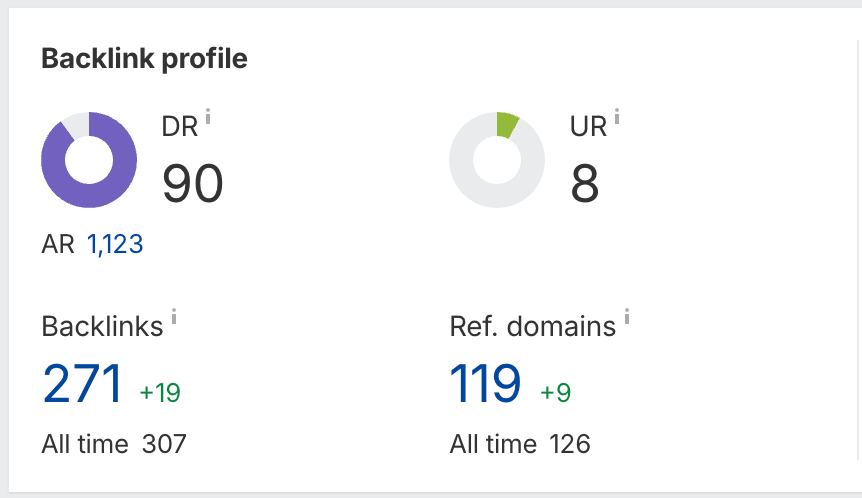
You should also create optimized landing pages for launches, align messaging with search interest from Google Trends, and repurpose campaign assets across blogs, YouTube, and social media, while being aligned to a list of tracked keywords.
Duolingo is a great example to take inspiration from.
When the company ran a viral campaign announcing the “death” of its mascot, searches for “Duolingo” spiked to record highs, resulting in a massive boost in branded traffic and organic reach.
Over just two weeks (February 4–17, 2025), the mascot was mentioned about 169,000 times online. On February 11 (the day the brand revealed Duo’s “death”) mentions shot up by more than 25,000% compared to normal levels.
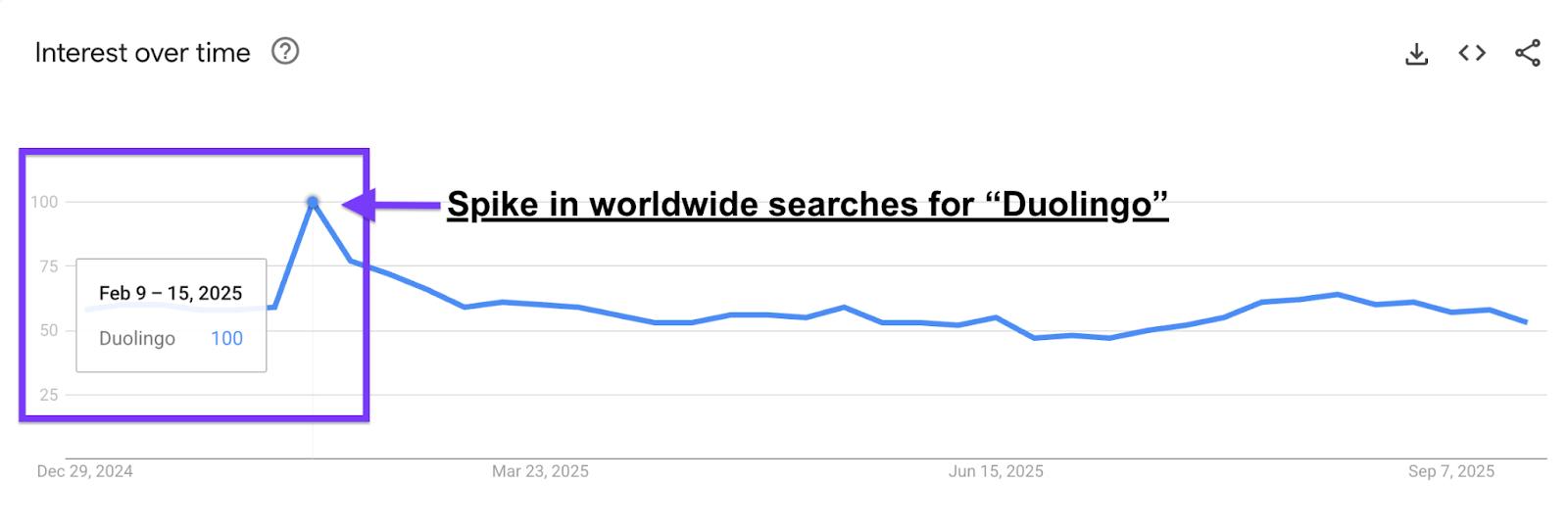
This surge in attention carried over to overall search interest, too, with global searches for “Duolingo” climbing by roughly 58% immediately after the campaign.
And campaigns don’t just drive short-term spikes.
According to Ahrefs’ analysis of AI visibility,
“off-site brand signals like web mentions and branded search volume drive AI visibility more than ads or backlinks.”
That means the combination of PR, mentions, and search-aligned assets can have a compounding effect on your brand health and brand’s market share long after the campaign ends.
By reclaiming mentions, owning your branded keywords, matching competitor visibility, and running campaigns that capture cultural attention, you create lasting lifts in branded searches.
Over time, these efforts strengthen brand health, expand online visibility, and help secure a larger brand’s market share in search.
Key takeaways
- Share of search (SoS) measures branded search volume for your brand compared to competitors.
- SoS reflects brand visibility, consumer interest, and brand health — and often predicts changes in market share.
- Calculate SoS with the formula: (Your brand’s branded search volume ÷ Total branded search volume for all brands) × 100.
- Identify branded keywords for your brand and competitors using tools like Google Trends and Surfer’s Chrome extension.
- Track branded keyword search volume monthly or quarterly to monitor changes in brand interest.
- Improve SoS by reclaiming unlinked brand mentions and turning them into backlinks.
- Create and optimize content for branded keywords, including reviews, comparisons (like what Zapier had done), FAQs, and pricing pages.
- Perform competitive backlink analysis to find and fill gaps where competitors are mentioned but you are not.
- Run brand-building campaigns that drive curiosity and branded searches — Duolingo’s viral mascot campaign is a strong example.
- Growing your SoS strengthens brand visibility, improves CTRs, and secures long-term gains in brand health and market share.




